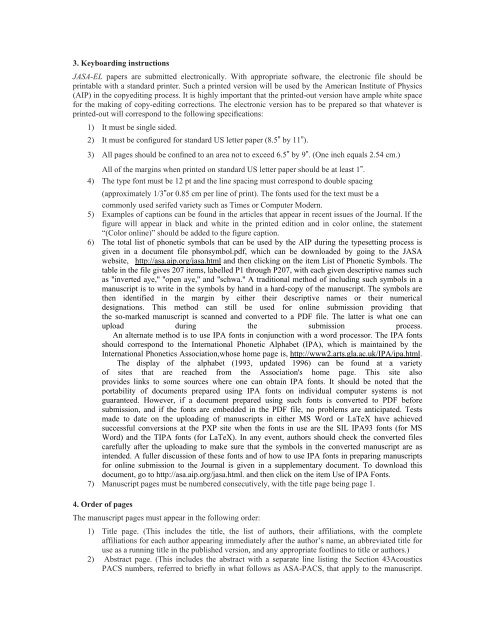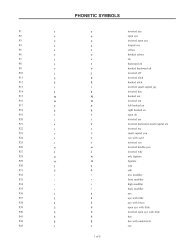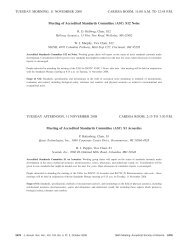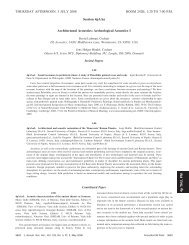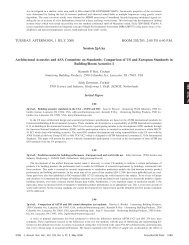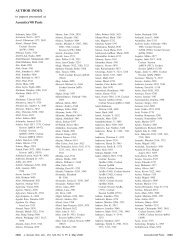Information for Contributors to JASA Express Letters - The Acoustical ...
Information for Contributors to JASA Express Letters - The Acoustical ...
Information for Contributors to JASA Express Letters - The Acoustical ...
You also want an ePaper? Increase the reach of your titles
YUMPU automatically turns print PDFs into web optimized ePapers that Google loves.
3. Keyboarding instructions<br />
<strong>JASA</strong>-EL papers are submitted electronically. With appropriate software, the electronic file should be<br />
printable with a standard printer. Such a printed version will be used by the American Institute of Physics<br />
(AIP) in the copyediting process. It is highly important that the printed-out version have ample white space<br />
<strong>for</strong> the making of copy-editing corrections. <strong>The</strong> electronic version has <strong>to</strong> be prepared so that whatever is<br />
printed-out will correspond <strong>to</strong> the following specifications:<br />
1) It must be single sided.<br />
2) It must be configured <strong>for</strong> standard US letter paper (8.5” by 11”).<br />
3) All pages should be confined <strong>to</strong> an area not <strong>to</strong> exceed 6.5” by 9”. (One inch equals 2.54 cm.)<br />
All of the margins when printed on standard US letter paper should be at least 1”.<br />
4) <strong>The</strong> type font must be 12 pt and the line spacing must correspond <strong>to</strong> double spacing<br />
(approximately 1/3”or 0.85 cm per line of print). <strong>The</strong> fonts used <strong>for</strong> the text must be a<br />
commonly used serifed variety such as Times or Computer Modern.<br />
5) Examples of captions can be found in the articles that appear in recent issues of the Journal. If the<br />
figure will appear in black and white in the printed edition and in color online, the statement<br />
“(Color online)” should be added <strong>to</strong> the figure caption.<br />
6) <strong>The</strong> <strong>to</strong>tal list of phonetic symbols that can be used by the AIP during the typesetting process is<br />
given in a document file phonsymbol.pdf, which can be downloaded by going <strong>to</strong> the <strong>JASA</strong><br />
website, http://asa.aip.org/jasa.html and then clicking on the item List of Phonetic Symbols. <strong>The</strong><br />
table in the file gives 207 items, labelled P1 through P207, with each given descriptive names such<br />
as ''inverted aye,'' ''open aye,'' and ''schwa.'' A traditional method of including such symbols in a<br />
manuscript is <strong>to</strong> write in the symbols by hand in a hard-copy of the manuscript. <strong>The</strong> symbols are<br />
then identified in the margin by either their descriptive names or their numerical<br />
designations. This method can still be used <strong>for</strong> online submission providing that<br />
the so-marked manuscript is scanned and converted <strong>to</strong> a PDF file. <strong>The</strong> latter is what one can<br />
upload during the submission process.<br />
An alternate method is <strong>to</strong> use IPA fonts in conjunction with a word processor. <strong>The</strong> IPA fonts<br />
should correspond <strong>to</strong> the International Phonetic Alphabet (IPA), which is maintained by the<br />
International Phonetics Association,whose home page is, http://www2.arts.gla.ac.uk/IPA/ipa.html.<br />
<strong>The</strong> display of the alphabet (1993, updated 1996) can be found at a variety<br />
of sites that are reached from the Association's home page. This site also<br />
provides links <strong>to</strong> some sources where one can obtain IPA fonts. It should be noted that the<br />
portability of documents prepared using IPA fonts on individual computer systems is not<br />
guaranteed. However, if a document prepared using such fonts is converted <strong>to</strong> PDF be<strong>for</strong>e<br />
submission, and if the fonts are embedded in the PDF file, no problems are anticipated. Tests<br />
made <strong>to</strong> date on the uploading of manuscripts in either MS Word or LaTeX have achieved<br />
successful conversions at the PXP site when the fonts in use are the SIL IPA93 fonts (<strong>for</strong> MS<br />
Word) and the TIPA fonts (<strong>for</strong> LaTeX). In any event, authors should check the converted files<br />
carefully after the uploading <strong>to</strong> make sure that the symbols in the converted manuscript are as<br />
intended. A fuller discussion of these fonts and of how <strong>to</strong> use IPA fonts in preparing manuscripts<br />
<strong>for</strong> online submission <strong>to</strong> the Journal is given in a supplementary document. To download this<br />
document, go <strong>to</strong> http://asa.aip.org/jasa.html. and then click on the item Use of IPA Fonts.<br />
7) Manuscript pages must be numbered consecutively, with the title page being page 1.<br />
4. Order of pages<br />
<strong>The</strong> manuscript pages must appear in the following order:<br />
1) Title page. (This includes the title, the list of authors, their affiliations, with the complete<br />
affiliations <strong>for</strong> each author appearing immediately after the author’s name, an abbreviated title <strong>for</strong><br />
use as a running title in the published version, and any appropriate footlines <strong>to</strong> title or authors.)<br />
2) Abstract page. (This includes the abstract with a separate line listing the Section 43Acoustics<br />
PACS numbers, referred <strong>to</strong> briefly in what follows as ASA-PACS, that apply <strong>to</strong> the manuscript.


